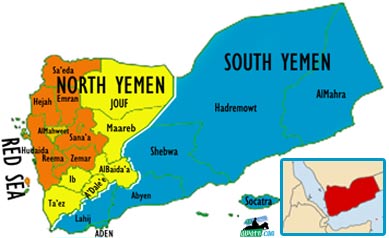InJanuary of this year, a group of Shi’a rebels in Yemen referred to in the West as the “Houthis” marched into the Yemeni capital Sana’a, forcing the current president Abd Rabbu Mansour Hadi to flee to the southern city of Aden and eventually leave the country altogether. These rebels were supposedly fighting to convince President Hadi and his administration to reconsider a constitution that would divide the country into six federal regions. The Houthis also accused the Yemeni government of willingly harboring al-Qaeda in the Arab Peninsula (AQAP) in the southern part of the country. Because of this, they see their conquest of Yemen as something justified to ensure the safety of Yemenis and security of the region.
Iran, the only majority Shi’a Muslim country in the world, has been named a likely supporter of the rebels for religious reasons. Meanwhile, Saudi Arabia, a Sunni majority country and spiritual home of Islam, has been sponsoring airstrikes against the Houthis to prevent their advancement and protect Sunni Yemenis. Because these two major Muslim powers are supporting opposite sides in the conflict, the crisis in Yemen has been portrayed as a “proxy war” between Sunni Saudi Arabia and Shi’a Iran. While it cannot be denied that both countries are at odds with one another and want to protect their interests in the region, the history and demographics of Yemen may say more about the conflict than any theories about foreign intervention.
The present day Republic of Yemen consists of two formerly independent countries which united in 1990: the Yemen Arab Republic (North Yemen) and the People’s Democratic Republic of Yemen (South Yemen). Despite the use of the terms “north” and “south” to imply some kind of Korea-like split, the two Yemens had never been formally unified prior to 1990 and developed along different political and religious lines.
North Yemen’s origin can be traced back to the founding of a Zaydi Shi’a imamate, a theocracy ruled by an imam, by Imam Yahya in 897. Yahya, a descendant of the Prophet Muhammad, was the first to unify the northern part of Yemen under Islamic rule. He united the tribes in northern Yemen under what would later be called Zaydi Shi’ism, of which former Yemeni president Ali Abdullah Saleh and the Houthis are followers. This imamate was ruled by Yahya’s descendants for more than 1,000 years and, except during the 12th century, was separated from the southern part of Yemen. It was not until 1962 that the imamate would be overthrown during a wave of Arab nationalism and North Yemen would be established.
South Yemen has a different story. The area of southern Yemen, other than being briefly ruled by the Ottomans and the Ayyubid Dynasty, had been largely ungoverned due to its sparse population and harsh environment. But in the 19th century the British began looking for a place, ideally on the Arab peninsula, where they could service ships en route to India. Originally, the British negotiated with the Zaydi imamate about building a settlement in its territory, but the negotiations failed. The British then conquered Aden, the future South Yemeni capital, in 1839 and made it a part of British India. Aden became a crown colony in 1937 and, in 1963, Britain annexed all of the future South Yemeni territory to form a protectorate under the name “Federation of South Arabia.”
The British promised independence to the Federation of South Arabia by 1968, but Yemenis soon rose up in revolt to combat the British forces in what is now called the “Aden Emergency.” During this conflict, which lasted for four years and resulted in about 2,000 deaths, Arab nationalists formed the National Liberation Front (NLF) and fought the British using guerilla tactics. The British left Aden by November 1967 and the NLF beat out their competitors for control, establishing the People’s Republic of Yemen. However, a radical Marxist faction within the NLF took over a few years later and renamed the country the People’s Democratic Republic of Yemen, a Soviet satellite state.
North and South Yemen maintained relatively friendly relations throughout their existences and both countries expressed that they favored unification despite clear differences. A CIA report from 1990 examined the concerns of many South Yemenis who were worried that merging with the more populated North would allow the North to “dominate” the South. In a way, this is exactly what happened after the two merged in 1990 to form the Republic of Yemen. The leader of North Yemen, Ali Abdullah Saleh, became the president of the newly unified Yemen while Ali Salim al-Beidh, the leader of South Yemen, became the vice president. However, within a few years, South Yemenis again declared independence and the resulting civil war in 1994 exposed the longstanding rift between North and South Yemen.


And now we come back to the Sunni-Shi’a split which currently characterizes the conflict in Yemen. As previously mentioned, North Yemen had long been home to Zaydi Shi’a Muslims and the first president of a unified Yemen, Ali Abdullah Saleh, was a Shi’a Muslim himself. Shi’a Muslims make up about 40 percent of Yemen’s population but they are almost all concentrated in what used to be North Yemen, where the capital Sana’a and most of the population of Yemen is located. The former South Yemen, however, is overwhelmingly Sunni and is also home to a number of socialists who reject being linked to North Yemen’s religious past. Now, although he originally fought the Houthis, Saleh, ousted from office in 2012, is standing behind them to continue the legacy of Shi’a domination in a unified Yemen in clear disregard of the concerns of southerners.
The current “civil war” taking place in Yemen has been labelled as such because, in general, the belligerents are the forces loyal to acting president Hadi and the Houthis. But now, as foreign powers get involved in the conflict, this characterization of the conflict is less applicable. The United States and Saudi Arabia claimed to have sided with Hadi loyalists because Houthi advances have halted their campaign against AQAP, seen as the “most dangerous” branch of al-Qaeda. But, as previously stated, the Houthis are just as determined to wipe out AQAP as the U.S. or Saudi Arabia are since they are Shi’a. So why are two groups with identical goals fighting each other? The answer is regional tensions and separatist sentiments that have been brewing ever since the unification of Yemen. Although the Houthis had been active since the early 2000s, the election of Hadi, a southerner and Sunni Muslim, was the final piece of evidence for the rebels that the Shi’a in northern Yemen were losing ground to the Sunni majority. Even though Saleh had opposed the Houthis before, he was a northerner and ruled Yemen for 22 years before his stepping down. Saleh solidified Shi’a and northern domination of all of Yemen while southerners were relegated to a lesser status. The Houthis are not trying to establish something new but rather continue what has been the norm for Yemen since its unification. Even though a split at this time may devastate the underdeveloped South Yemen, this civil war has proven that this split may be inevitable as the two different regions cannot find common ground.
– By Alexander Boylston


